debbie Hamrick — November 1, 2014
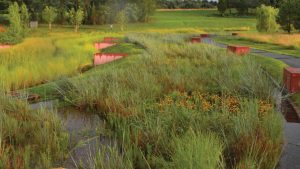
Growers looking for a way to make a difference—and to make a profit—can turn to the emerging field of green infrastructure.
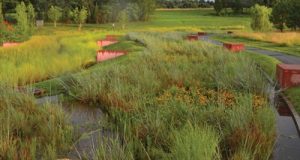
Click image to enlarge.
The pond project at the North Carolina Museum of Art, two year after installation.
Photo courtesy of Stephen H. Blake, Artifex Environmental Design, Inc.
Green infrastructure offers the nursery industry a new market for plants and horticultural services. Broadly defined, this emerging market spotlights all the functions plants can serve in the urban landscape—everything from increasing stormwater infiltration at the site level, to reducing temperatures locally, to providing beneficial wildlife habitat and boosting property values citywide.
Click image to enlarge.
The pond project at the North Carolina Museum of Art employed green infrastructure features to manage and treat stormwater on site. The project used a large number of locally sourced liners and container-grown plants.
Photo courtesy of John Hoffman
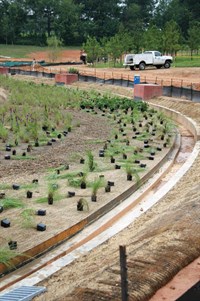
Stormwater management drives demand
One of the largest emerging green infrastructure (GI) plant markets entails plants for site-specific stormwater management. In these cases, it is primarily the landscape architects working with engineering firms—those who are implementing a private or public contract for the project—who generate plant demand.
In markets where regulations or rules frame GI plant selection, nurseries and greenhouse growers are seeing boosts in demand. And it’s often for natives of all kinds—trees, shrubs, perennials and grasses. Approved plant lists for projects are typically included in best management practices (BMP) manuals for stormwater control or new or infill development.
Hoffman Nursery is one of several North Carolina nurseries that has noticed increased demand for native plants, including those recommended in BMP manuals. In response, the company has begun growing a wider range of native grasses and sedges. Growers are also seeing an increase in requests for plants and seed mixes for pollinator habitat and wildlife forage.
Positioning our industry
Nurserymen or landscape contractors involved with GI projects frequently note a disconnect between project expectations and their own industry experience. The composition of the media in the site structure, the plant selection and the timeline all have been finalized before these professionals join the process: The nursery and landscape industry is at the tail end of GI demand. Often by the time plant lists are submitted for fulfillment or jobs are bid, most decisions that frame the project have been determined.
But how do we position the industry in these discussions? In North Carolina, the NC Green Industry Council (NCGIC) undertook two projects to gain insights into how the nursery and landscape industry can play a role in GI markets.
In March 2014 the NCGIC surveyed a selection of GI practitioners in North Carolina. Titled “Planning for Green Infrastructure Growth,” the survey queried respondents about the practices they use and the role plants play in their projects. Later, in July, NCGIC’s annual water seminar focused on GI and featured a range of national level speakers. The seminar, “Developing Green Infrastructure—Contributing to a Healthy Future for Water and People,” offered talks from various perspectives including municipal utility, site design, stormwater engineering, plant performance, infiltration, installation and maintenance. In this article, we help frame the emerging GI market for the nursery industry by providing a broad overview and highlighting some key points from these activities.
Regulation drives GI
Large cities like Atlanta, Milwaukee, New York, Philadelphia, Portland, Seattle and Washington, D.C., plan to make multimillion and multibillion dollar investments in GI over the next 20 years to meet federal EPA water standards. Counties and states are mandating GI in regulations for new and renewal development projects.
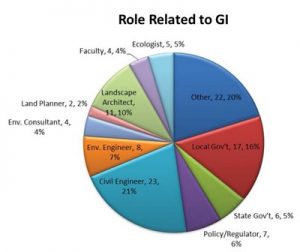
Click image to enlarge.
Figure 1: Number of and Percent of Total Respondents Who Reported Each Role
At the NCGIC seminar Mami Hara, First Deputy Water Commissioner for the Philadelphia Water Department, delivered the keynote address. She revealed that Philadelphia is approaching stormwater management entirely through GI in order to meet EPA regulatory requirements for the city’s combined sewer/stormwater system.
Investing in greened acres offers opportunities
Hara says Philadelphia’s cost savings for using GI is huge. Using old technology to manage the system would cost $10 billion and take 25 years to construct. With their GI plan, the city will spend $2 billion over the next 20 years to create 10,000 greened urban acres instead. One greened acre can accommodate a 1-inch rain event.
To meet Philadelphia’s 10,000 greened acres goal, projects will include stormwater features that incorporate and rely on plant material—green roofs, bioretention structures, vegetated swales and others. Philadelphia’s plan has the potential to be a boon for plant and seed sales.
Hara explained there’s plenty of opportunity when it comes to plant material for GI. Two of the greatest needs, she claimed, are better plant sources and better plant palettes: “The way things look is important.” She emphasized that aesthetics increases adoption and acceptance, which are critical for the initiative to succeed.
The city is partnering with a broad range of stakeholders, from regulatory agencies to environmental organizations to public health institutions. It is also working with groups from the green industry. According to Hara, “If you don’t think you’re a partner with us, you just don’t know it yet.” She emphasized the need for better research on what works in GI and the potential for partnering. “We have to go big to succeed. We need a loud, diverse and responsive green industry to go with us,” she explained.
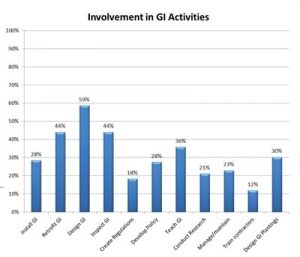
Click image to enlarge.
Figure 2: Percent of Respondents Involved in Each GI Activity
NCGIC surveys practioners
Several industry members, with help from the NCGIC, conducted an informal survey, “Planning for Green Infrastructure Growth.” The survey was distributed to attendees at the NC Low Impact Development (LID) Summit in Raleigh, North Carolina, in March 2014. Of 139 people registered for the summit, 85 completed the survey. After the conference, an electronic version was e-mailed to LID summit attendees and sent via the state’s stormwater list serve. An additional 52 people completed this online version, for a total of 137 respondents.
The survey included initial screening questions to determine which respondents were actually involved or had been involved in GI. Only those who were involved were asked to complete the entire survey. A total of 109 (80 percent) were involved or had been involved in LID/GI and completed the full survey. Further survey results are reported for the 109 only.
More than a quarter of the group were engineers, followed by local or state government employees and landscape architects. Figure 1 shows the breakdown of reported roles. When asked what GI activities they were involved in, more than half of the respondents indicated they designed GI features. They were also heavily involved in retrofitting and inspecting them (see Figure 2).
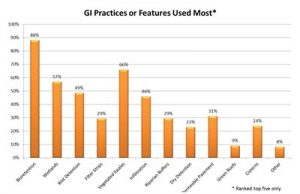
Click image to enlarge.
Figure 3: GI Features and the Percent of Respondents Who Reported That Feature in Their Top Five
Survey says …
In terms of why people were using GI features, the answer was clear. Most GI projects were driven by regulations. More than two-thirds of the respondents who worked in GI said compliance with governmental rules at either the federal, state or watershed level was their top reason for using GI features in their projects. Federal EPA stormwater regulations seek to control the amount of pollution running into surface waters, and they are at the base of the regulatory framework.
Hara’s comments on the need for green industry involvement in GI are consistent with what we found in the NCGIC survey. Two main points emerged from the results:
- respondents indicate plants play a major role in LID/GI; and
- there are important difficulties to overcome in realizing the full potential of plants for LID/GI.
The survey asked respondents to rank their top five GI practices. The activities and the percent of respondents who ranked them in their top five are presented in Figure 3. For these practitioners, features that employ plant material dominated:
- bioretention or rain gardens
- vegetated or grassed swales
- stormwater wetlands
- wet detention basins
Respondents also rated the importance of plants for various aspects of GI features they’ve used. Average ratings on a 1 to 5 scale (with five being very important) were all 4.0 or greater for pollutant removal, reducing runoff, public perception, aesthetics, supporting wildlife and overall function. Respondents clearly believe plants are important for the features they are using.
Plants are vital for GI, but …
The NCGIC survey also probed for difficulties respondents have experienced with GI features. The percentage of participants who experienced each difficulty is presented in Figure 4. Maintenance burden, long-term survival of plant material and colonization by invasive species or Urban Landscape Market Continued from page 19 weeds seemed to pose the greatest difficulties. Even though respondents believe plants are very important for GI, they currently experience serious problems related to plant material. Interestingly, while many participants reported problems with the plants, far fewer reported problems specifying plants.
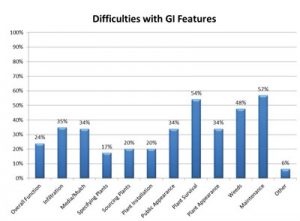
Click image to enlarge.
Figure 4: Percent of Respondents Who Reported Each Difficulty with GI Features
Landscape architect Jesse Turner worked on the design team for a large GI project at the North Carolina Museum of Art. He notes that with GI features, maintenance is crucial, especially if the planting plan is fairly diverse and not all plants will grow to fill in and out-compete unwanted plants. Turner also says plant selection can go a long way toward reducing maintenance and increasing survivability.
Who’s specifying the plants?
The survey also included items about plant selection. Respondents were asked which parties typically specify plants for GI features. More than two-thirds said landscape architects were choosing the plants and more than one-third said engineers were. Horticulturists and landscape designers were mentioned far less often.
Another survey item asked where the person specifying plants gets information on which plants are appropriate. Results from this item are presented in Figure 5. Technical manuals for stormwater BMP, GI or LID were cited almost two-thirds of the time. This was followed by training in a field such as botany, horticulture or landscape design, or the professional designing the project (landscape architect or engineer). Interestingly, a nursery or other plant supplier played a role in plant information for a third of respondents. In a final question, more than half of respondents indicated that the installation contractor is responsible for sourcing plant material.
Finding opportunities
Hoffman Nursery has seen an increase in contractors trying to source plants for GI features. Unfortunately, the request often comes at the last minute and involves plants that are unfamiliar to them. For example, one of North Carolina’s stormwater BMP manuals includes Carex species on the recommended list of plants for bioretention. With more than 100 species of native Carex, matching a species to a particular GI project is challenging, even for nursery pros.
Contractors are often frustrated not knowing which plants to choose, or they may have little or no control over the plant list. Conversely, design professionals are often exasperated when plants they’ve chosen aren’t available at installation.
One can imagine a better process. Collaboration among project designers, landscape contractors and nursery suppliers early in the planning process might address some of these difficulties.
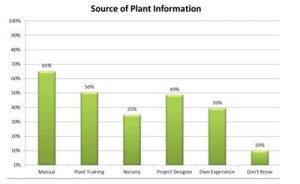
Click image to enlarge.
Figure 5: Percent of Respondents Who Reported Each Source of Plant Information
The results of the NCGIC survey suggest potential strategies for industry players to work within GI markets. Addressing and solving problems such as plant survival and maintenance can be accomplished through plant selection, maintenance training and partnering early in the planning process. In addition, positioning marketing messages to focus on the benefits of plants, such as enhanced visual appeal, while emphasizing their ability to increase GI feature functionality will help firms target emerging GI markets.
Communicating with project leaders, such as engineers and landscape architects, may entail developing different language to describe plant appearance and function. It may mean supplying technical support in the form of research papers or other data to validate choices. In cases where practitioners don’t know what works best, our industry could play a role in helping determine best practices.
Longer term, there are opportunities for our industry to address plant survival and other difficulties by being involved in GI policy and regulations. For instance, specified media mixes may not provide adequate sustenance or water-holding capacity for the plant establishment phase. Additionally, many BMP lists include a limited number of native species that may or may not be the best performing plants for specific GI uses. Including GI plant performance and landscape functionality as a metric for introduction is another potential long-term opportunity.
Most of all, the NCGIC survey and discussions with GI practitioners spotlight the need to learn more about this emerging market. Green infrastructure is in its infancy, and the green industry’s prospects are exciting. As an industry, let’s explore partnerships and look for ways to increase our role in the process.
The authors would like to thank the North Carolina Coastal Federation for their assistance in distributing the NCGIC survey at the NC LID Summit and Frank Franciosi of Novozymes, representing the NC Composting Council, for his contributions to the survey project.
Shannon Currey is Marketing Director with Hoffman Nursery in Rougemont, North Carolina; the company grows ornamental and native grasses. Prior to training in horticulture, she worked as a social science researcher at the University of North Carolina at Chapel Hill. She can be reached at [email protected].
Debbie Hamrick is Director of Specialty Crops with the North Carolina Farm Bureau Federation in Raleigh and is a NCGIC Board Advisor. She can be reached at [email protected].
For more information
To access presentations from the NCGIC’s seminar “Developing Green Infrastructure- Contributing to a Healthy Future for Water and People,” go to: http://www.savingwaternc.com/2014-water-symposium/ registration-closed/
To see a PDF of the NCGIC survey, “Planning for Green Infrastructure,” go to: http://www.hoffmannursery.com/documents/NCGIC_Survey_Planning-for-GI-Growth.pdf